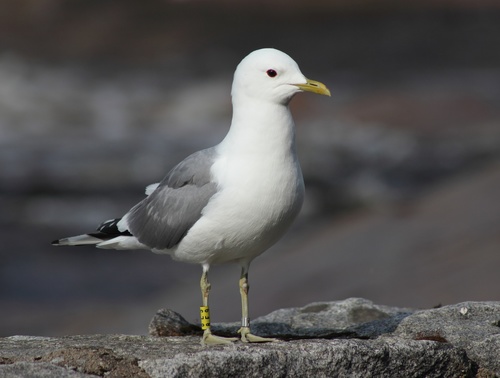
Common Gull
The Common Gull (*Larus canus*) is a medium-sized gull that, despite its name, is not the most common gull species in many areas. It is known for its relatively gentle appearance compared to larger gulls, with a smaller bill and more rounded head. Ecologically, it plays a role as both predator and scavenger, contributing to nutrient cycling in coastal and inland habitats. It holds no particular strong cultural significance but is a familiar sight to many coastal residents across its range.
40-46 cm
Length
100-130 cm
Wingspan
Least Concern
Conservation Status
Distribution
The Common Gull breeds across northern Europe, northern Asia, and northwestern North America. It migrates south for the winter, reaching coastal areas of Western Europe, the Mediterranean, East Asia, and the western coast of North America, down to Baja California. It also has an altitudinal range from sea level to inland lakes and reservoirs.
Lifespan
Up to 24 years recorded in the wild, though typically shorter.
Common Gull's Habitat
Habitat Types
Coastal areas, Estuaries, Inland lakes, Reservoirs, Agricultural fields, Urban parks
Climate Zones
Boreal, Temperate, Subarctic
Adaptations
Common Gulls are adaptable to a variety of habitats, showing flexibility in their foraging behavior. They can exploit both natural and human-modified environments. They have webbed feet for swimming and efficient flight for long-distance migration.
Variations
There are three generally recognized subspecies: *L. c. canus* (Europe), *L. c. heinei* (Russia), and *L. c. kamtschatschensis* (Northeast Asia). A fourth, *L. c. brachyrhynchus* (Alaska and Canada), is sometimes recognized, and sometimes considered a separate species (Mew Gull).
Appearance
Breeding Plumage
Breeding adults have a white head, body, and tail, with a grey back and upperwings. Non-breeding adults develop grey streaking on the head and neck.
Seasonal Feather Changes
The head streaking is most prominent in winter and fades as the breeding season approaches.
Sex Based Plumage Differences
Minimal; males and females have very similar plumage.
Notable Features
Yellow bill with a small black ring near the tip (in breeding plumage)., Yellowish-green legs., Dark eyes., Relatively slender bill compared to other gulls.
Diet and Feeding
Primary Foods
Small fish, Invertebrates (insects, earthworms, crustaceans), Mollusks, Carrion, Berries, Seeds, Human refuse
Foraging Behavior
Common Gulls are opportunistic feeders, employing a variety of techniques. They forage while walking, wading, swimming, or flying. They may dip into the water, scavenge on shorelines, or follow plows in fields to pick up earthworms.
Specializations
They are less specialized than some other gull species, exhibiting a generalist diet and foraging strategy.
Seasonal Diet Variations
Their diet varies seasonally and regionally depending on food availability. In winter, they may rely more on scavenging and human-provided food sources.
Behavior
Social Structure
Common Gulls are often found in flocks, especially outside the breeding season. They can form large roosting aggregations. During breeding, they may nest in loose colonies.
Communication
A variety of calls, including a high-pitched 'kyow' call., Head-tossing and other visual displays., Alarm calls to warn of predators.
Migration
Many populations are migratory, traveling significant distances between breeding and wintering grounds. The timing and routes vary depending on the breeding location.
Territorial or Group Behaviors
During the breeding season, they defend a small territory around their nest. Outside of breeding, they are generally less territorial and more gregarious.
Conservation
Threats
Habitat loss and degradation (particularly coastal development), Pollution (including plastic ingestion and oil spills), Disturbance at breeding colonies, Climate change (affecting prey availability and nesting sites)
Protection Programs
International agreements for migratory bird protection., Designation of protected areas for breeding and wintering sites., Monitoring programs to track population trends.
Local National Laws
Protected under various national and international laws, such as the Migratory Bird Treaty Act in the United States and similar legislation in Europe.
Population Trend
Stable
Population Estimates
The global population is estimated to be in the millions, though precise figures are difficult to obtain.
Interesting Facts
They are known to follow fishing boats and farm machinery.
This behavior allows them to take advantage of readily available food sources.
They can drink both fresh and salt water.
They have specialized salt glands that allow them to excrete excess salt.
They are relatively long-lived for a bird of their size.
This allows for multiple breeding attempts over their lifespan.
Faqs about Common Gull
Are Common Gulls really common?
The name can be misleading. While widespread, they are not always the most numerous gull species in a given area.
What is the difference between a Common Gull and a Ring-billed Gull?
Ring-billed Gulls have a more distinct black ring around their bill, and are generally found more in North America. Common Gulls have a smaller black marking and are found in Eurasia and North America.
Do Common Gulls attack people?
They are generally not aggressive towards humans unless defending their nests or young.
Copyright @ Nature Style Limited. All Rights Reserved.
 English
English